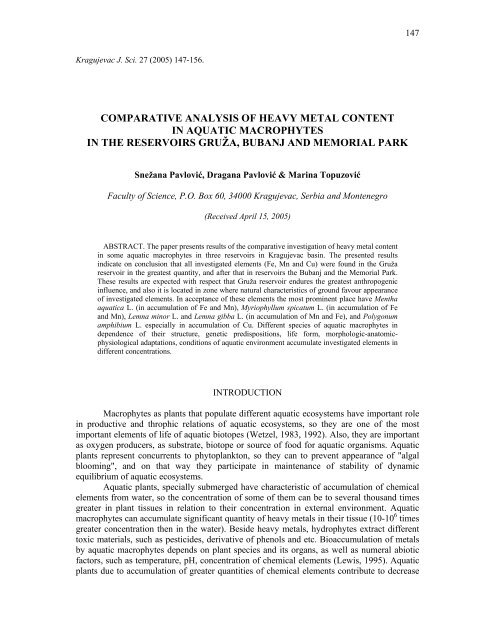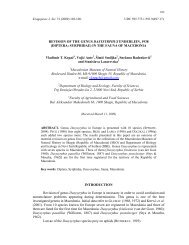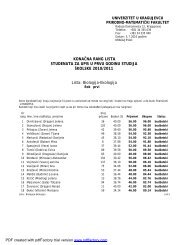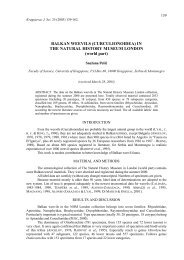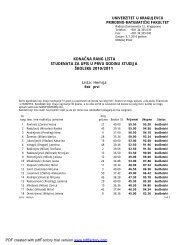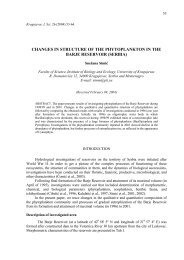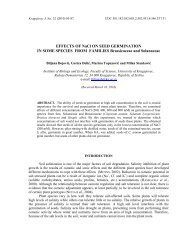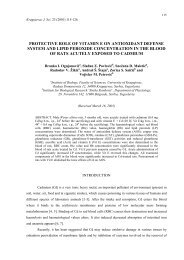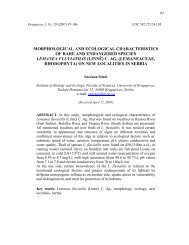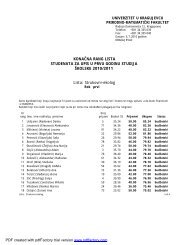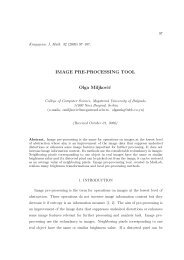comparative analysis of heavy metal content in aquatic macrophytes ...
comparative analysis of heavy metal content in aquatic macrophytes ...
comparative analysis of heavy metal content in aquatic macrophytes ...
Create successful ePaper yourself
Turn your PDF publications into a flip-book with our unique Google optimized e-Paper software.
147Kragujevac J. Sci. 27 (2005) 147-156.COMPARATIVE ANALYSIS OF HEAVY METAL CONTENTIN AQUATIC MACROPHYTESIN THE RESERVOIRS GRUŽA, BUBANJ AND MEMORIAL PARKSnežana Pavlović, Dragana Pavlović & Mar<strong>in</strong>a TopuzovićFaculty <strong>of</strong> Science, P.O. Box 60, 34000 Kragujevac, Serbia and Montenegro(Received April 15, 2005)ABSTRACT. The paper presents results <strong>of</strong> the <strong>comparative</strong> <strong>in</strong>vestigation <strong>of</strong> <strong>heavy</strong> <strong>metal</strong> <strong>content</strong><strong>in</strong> some <strong>aquatic</strong> <strong>macrophytes</strong> <strong>in</strong> three reservoirs <strong>in</strong> Kragujevac bas<strong>in</strong>. The presented results<strong>in</strong>dicate on conclusion that all <strong>in</strong>vestigated elements (Fe, Mn and Cu) were found <strong>in</strong> the Gružareservoir <strong>in</strong> the greatest quantity, and after that <strong>in</strong> reservoirs the Bubanj and the Memorial Park.These results are expected with respect that Gruža reservoir endures the greatest anthropogenic<strong>in</strong>fluence, and also it is located <strong>in</strong> zone where natural characteristics <strong>of</strong> ground favour appearance<strong>of</strong> <strong>in</strong>vestigated elements. In acceptance <strong>of</strong> these elements the most prom<strong>in</strong>ent place have Mentha<strong>aquatic</strong>a L. (<strong>in</strong> accumulation <strong>of</strong> Fe and Mn), Myriophyllum spicatum L. (<strong>in</strong> accumulation <strong>of</strong> Feand Mn), Lemna m<strong>in</strong>or L. and Lemna gibba L. (<strong>in</strong> accumulation <strong>of</strong> Mn and Fe), and Polygonumamphibium L. especially <strong>in</strong> accumulation <strong>of</strong> Cu. Different species <strong>of</strong> <strong>aquatic</strong> <strong>macrophytes</strong> <strong>in</strong>dependence <strong>of</strong> their structure, genetic predispositions, life form, morphologic-anatomicphysiologicaladaptations, conditions <strong>of</strong> <strong>aquatic</strong> environment accumulate <strong>in</strong>vestigated elements <strong>in</strong>different concentrations.INTRODUCTIONMacrophytes as plants that populate different <strong>aquatic</strong> ecosystems have important role<strong>in</strong> productive and throphic relations <strong>of</strong> <strong>aquatic</strong> ecosystems, so they are one <strong>of</strong> the mostimportant elements <strong>of</strong> life <strong>of</strong> <strong>aquatic</strong> biotopes (Wetzel, 1983, 1992). Also, they are importantas oxygen producers, as substrate, biotope or source <strong>of</strong> food for <strong>aquatic</strong> organisms. Aquaticplants represent concurrents to phytoplankton, so they can to prevent appearance <strong>of</strong> "algalbloom<strong>in</strong>g", and on that way they participate <strong>in</strong> ma<strong>in</strong>tenance <strong>of</strong> stability <strong>of</strong> dynamicequilibrium <strong>of</strong> <strong>aquatic</strong> ecosystems.Aquatic plants, specially submerged have characteristic <strong>of</strong> accumulation <strong>of</strong> chemicalelements from water, so the concentration <strong>of</strong> some <strong>of</strong> them can be to several thousand timesgreater <strong>in</strong> plant tissues <strong>in</strong> relation to their concentration <strong>in</strong> external environment. Aquatic<strong>macrophytes</strong> can accumulate significant quantity <strong>of</strong> <strong>heavy</strong> <strong>metal</strong>s <strong>in</strong> their tissue (10-10 6 timesgreater concentration then <strong>in</strong> the water). Beside <strong>heavy</strong> <strong>metal</strong>s, hydrophytes extract differenttoxic materials, such as pesticides, derivative <strong>of</strong> phenols and etc. Bioaccumulation <strong>of</strong> <strong>metal</strong>sby <strong>aquatic</strong> <strong>macrophytes</strong> depends on plant species and its organs, as well as numeral abioticfactors, such as temperature, pH, concentration <strong>of</strong> chemical elements (Lewis, 1995). Aquaticplants due to accumulation <strong>of</strong> greater quantities <strong>of</strong> chemical elements contribute to decrease
149and long 208.5 m. Length <strong>of</strong> reservoir is 1300 m, and average width is 175 m. Maximaldepth is 14 m. Volume <strong>of</strong> the reservoir is 950 000 m 3 , and surface is 20 ha. This reservoir wasbuilt for irrigation <strong>of</strong> park area, but it do not use for it. It has purpose <strong>in</strong> esthetic formation <strong>of</strong>Memorial Park, as object for recreation <strong>of</strong> citizens <strong>of</strong> the Kragujevac, sport, fish<strong>in</strong>g,ma<strong>in</strong>ta<strong>in</strong><strong>in</strong>g <strong>of</strong> sanitation department (Milenković, 2003).Figure 2. The Memorial Park reservoirThe Bubanj reservoir (Fig.3) was formed near asphalt road Kragujevac-Batoč<strong>in</strong>a. Itorig<strong>in</strong>ated <strong>in</strong> alluvial plateau <strong>of</strong> the Lepenica river, <strong>in</strong> abandoned cavity where exploitation <strong>of</strong>soil for factory <strong>of</strong> bricks was done. Exploitation was performed until 1955, when process <strong>of</strong>form<strong>in</strong>g reservoir started. Surface <strong>of</strong> the reservoir is on altitude <strong>of</strong> 168 m, and the greatestlength is <strong>in</strong> the north-east direction and it is 300 m; the greatest width is 215 m. Surface <strong>of</strong> thereservoir is 3.7 ha; average depth is 1.5 m (Stepanović, 1974). Recent studies <strong>in</strong>dicate that thewidth is decreased on 1.27 m (maximal depth is 1.6 m, and m<strong>in</strong>imal is 0.5 m). Dur<strong>in</strong>gsummer period, temperature <strong>of</strong> water goes to 29°C, and dur<strong>in</strong>g w<strong>in</strong>ter the reservoir is frozen.The biggest part <strong>of</strong> reservoir bottom makes mud, which average thickness is 0.5-0.7 m. Thereservoir gets water by ra<strong>in</strong>fall and from dr<strong>in</strong>k<strong>in</strong>g founta<strong>in</strong> Bubanj, as well as from theground spr<strong>in</strong>gs.Figure 3. The Bubanj reservoir
150MATERIAL AND METHODSWork <strong>in</strong> field was carried out dur<strong>in</strong>g spr<strong>in</strong>g and summer <strong>of</strong> 2004. Sample <strong>of</strong> <strong>aquatic</strong>plants were taken from places with the greatest their number and cover<strong>in</strong>g. The plants werecollected under favorable weather conditions by adequate equipment.Determ<strong>in</strong>ation <strong>of</strong> plant material was performed <strong>in</strong> laboratory <strong>of</strong> Institute <strong>of</strong> biologyand ecology (Faculty <strong>of</strong> Science) <strong>in</strong> Kragujevac. Determ<strong>in</strong>ation was carried out us<strong>in</strong>gb<strong>in</strong>ocular loupe and adequate literature: Javorka & Chapody (1975) and The Flora <strong>of</strong>Republic Serbia (Josifovic, 1970-1980). Life forms are given accord<strong>in</strong>g to the Raunckepr<strong>in</strong>ciple as elaborated by Mueller-Dumbois and Ellenberg (1974) and partially modified byStevanović (1992) <strong>in</strong> the Flora <strong>of</strong> Serbia.Determ<strong>in</strong>ed plant material was washed <strong>in</strong> distilled water until removal all impurity,and after that it is dried <strong>in</strong> dryer, 24 hours, on temperature <strong>of</strong> 105°C and than it is preparedfor chemical <strong>analysis</strong> accord<strong>in</strong>g to standard procedure, which applies for water and <strong>aquatic</strong>plants.After wash<strong>in</strong>g and dry<strong>in</strong>g on 105°C to constant mass, certa<strong>in</strong> quantity <strong>of</strong> the plantmaterial (approximately 2 g <strong>of</strong> sample with accuracy <strong>of</strong> ± 0.1 mg) was measured on analyticscale by method <strong>of</strong> differentiation <strong>in</strong> mass. Measured sample was transferred <strong>in</strong> balloonaccord<strong>in</strong>g to Kjeldal and perfused with concentrated HNO 3 . Reaction mixture was heatedcarefully by flame, until the solution became dry. Treatment was repeated until clear<strong>in</strong>g up <strong>of</strong>the solution, and stopp<strong>in</strong>g <strong>of</strong> releas<strong>in</strong>g <strong>of</strong> nitric vapors. After that, sample was cooled, and<strong>content</strong> <strong>in</strong> the Kjeldal′s dish was perfused with 6 ml <strong>of</strong> concentrated HClO 4 and than heated.Heat<strong>in</strong>g was stopped at solution volume <strong>of</strong> approximately 3 ml <strong>in</strong> Kjedal′s dish and whensolution has became clear and achromatic. After cool<strong>in</strong>g <strong>of</strong> solution, distillated water wasadded. After that, <strong>content</strong> from Kjeldal′s dish was filtrated through quantitative sieve <strong>in</strong>normal dish <strong>of</strong> 50 ml volume. On this way prepared solutions were used for determ<strong>in</strong>ation <strong>of</strong><strong>heavy</strong> <strong>metal</strong>s <strong>in</strong> plant material by atomic absorption spectrometer (Perk<strong>in</strong>-Elmer, model3300/96).RESULTS AND DISSCUSIONIn this study, <strong>in</strong>vestigations were done on certa<strong>in</strong> plants, from next reservoir: theGruža, the Memorial Park and the Bubanj. They showed that concentrations <strong>of</strong> the <strong>heavy</strong><strong>metal</strong>s vary <strong>in</strong> dependence <strong>of</strong> plant species and reservoir.In study, three <strong>heavy</strong> <strong>metal</strong>s (Fe, Mn and Cu) were <strong>in</strong>vestigated <strong>in</strong> tissues <strong>of</strong> nextplants: Myriophyllum spicatum (rooted, submerged), Polygonum amphibium (rooted,float<strong>in</strong>g), Lemna m<strong>in</strong>or (unrooted, float<strong>in</strong>g), Alisma plantago <strong>aquatic</strong>a (emerged), Menta<strong>aquatic</strong>a (emerged, Stevanović, 1992).Elements such as Cu, Mn, Zn, Co, Fe and others that belong to microelements, can befound <strong>in</strong> plants <strong>in</strong> very small concentrations <strong>in</strong> cells and tissues, but without them normalfunctions <strong>of</strong> cells and organism are not possible.In plant cells, the Fe has role <strong>in</strong> formation <strong>of</strong> chlorophyll and acceptance <strong>of</strong> anionsfrom substrate. The Fe is <strong>in</strong>cluded <strong>in</strong> structure <strong>of</strong> great number <strong>of</strong> enzymes that participate <strong>in</strong>processes <strong>of</strong> oxido-reduction <strong>in</strong> live cells, thanks to ability <strong>of</strong> easy receiv<strong>in</strong>g and releas<strong>in</strong>g <strong>of</strong>electrons. Citohroms conta<strong>in</strong> the Fe l<strong>in</strong>ked for chem, and chem is present <strong>in</strong> some oxidizes,peroxidazes and catalazes. Some transporters have <strong>in</strong> their <strong>in</strong>side Fe, but they do not haveporfir<strong>in</strong>ic core, as ferodox<strong>in</strong> and prote<strong>in</strong>s with Fe-S group. Also, the Fe is activator <strong>of</strong> someenzymes that participate <strong>in</strong> synthesis <strong>of</strong> porfir<strong>in</strong>ic r<strong>in</strong>g. In cell <strong>of</strong> leaf, excess <strong>of</strong> Fe is <strong>of</strong>tenb<strong>in</strong>d to one phosphoprote<strong>in</strong> and make crystals <strong>of</strong> fit<strong>of</strong>erit<strong>in</strong>. For absorption <strong>of</strong> Fe by plants
151fero (Fe +2 ) or feri (Fe +3 ) ions are very important. Increase <strong>of</strong> acidity <strong>in</strong>fluences on <strong>in</strong>crease <strong>of</strong>concentration <strong>of</strong> ferry ions. Fe ions do not accept directly from the solution, but fromcomplex with organic compounds (chelats and siderophors) where they are connected bycoord<strong>in</strong>ated bonds. In siderophors feri ion is l<strong>in</strong>ked and by that its accessibility is <strong>in</strong>creasedsome hundred times. The most known symptom <strong>of</strong> lack<strong>in</strong>g <strong>of</strong> the Fe is <strong>in</strong>terruption <strong>of</strong>chlorophyll synthesis, and because <strong>of</strong> that chlorozes arise at plants. The Fe is weakly mobile,so the chloroze first appears <strong>in</strong> young leafs (Nešković, Konjević and Ćulafić, 2003).The greatest average value <strong>of</strong> Fe concentration was observed <strong>in</strong> reservoir the Gružaand after that <strong>in</strong> reservoirs the Bubanj and the Memorial Park (Fig.4). The greatest <strong>content</strong> <strong>of</strong>the Fe was found at plant Mentha <strong>aquatic</strong>a from the Gruža reservoir, and at Myriophyllumspicatum <strong>in</strong> the Bubanj and the Memorial Park reservoirs (Fig.4). Increased <strong>content</strong> <strong>of</strong> the Fe<strong>in</strong> the Gruža reservoir occurred at plants Myriophyllum spicatum and Lemna gibba, and <strong>in</strong>Memorial Park at plants Mentha <strong>aquatic</strong>a and Polygonum amphibium (Fig.4). In the Bubanjreservoir (Fig.4), the Fe was more present at Mentha <strong>aquatic</strong>a and Lemna m<strong>in</strong>or.For the Mn some row <strong>of</strong> roles <strong>in</strong> oxido-reduction processes is suggested. This iselement which is part <strong>of</strong> ferments, and especially it has important catalytic function at some<strong>of</strong> ferments, such as enolase, hydrogenase, phosphoglucomutase, carboxylase, etc. The Mn isstimulator <strong>of</strong> plant growth, and two-valence Mn activates many enzymes <strong>in</strong> synthesis <strong>of</strong> fatand nucleic acids. It is part for complex for releas<strong>in</strong>g <strong>of</strong> oxygen <strong>in</strong> chloroplasts. Increased<strong>content</strong> <strong>of</strong> the Mn <strong>in</strong>fluences decrease <strong>in</strong> acceptance <strong>of</strong> N, P, K, Ca, but because <strong>of</strong> economicus<strong>in</strong>g <strong>of</strong> noted elements there is not change <strong>in</strong> yield <strong>of</strong> plants. In case <strong>of</strong> lack<strong>in</strong>g <strong>of</strong> Mn,disorganization <strong>of</strong> lamellar system <strong>of</strong> chloroplast occurs, and because <strong>of</strong> chlorotic andnecrotic specks appear <strong>in</strong> mesophyle <strong>of</strong> a leaf (Nešković, Konjević and Ćulafić, 2003). TheMn <strong>in</strong> excess leads to appearance <strong>of</strong> chloroze due to lack<strong>in</strong>g <strong>of</strong> Fe, because <strong>of</strong> antagonism <strong>of</strong>these two elements.The greatest average values <strong>of</strong> Mn concentration is found <strong>in</strong> the Gruža reservoir(Fig.5), and after that <strong>in</strong> the Bubanj and the Memorial Park reservoirs (Fig.5). The Mentha<strong>aquatic</strong>a was plants that has the greatest acceptance <strong>of</strong> Mn on all localities. At the Gružareservoir, Lemna gibba and Myriophyllum spicatum have more important acceptance <strong>of</strong> theMn, but <strong>in</strong> the Memorial Park reservoir that role have Myriophyllum spicatum and Alismaplantago <strong>aquatic</strong>a. At the Bubanj reservoir Lemna m<strong>in</strong>or and Myriophyllum spicatum havemore important acceptance <strong>of</strong> Mn.The Cu is important element <strong>in</strong> synthesis <strong>of</strong> prote<strong>in</strong>s, but also as elements which ispart <strong>of</strong> oxidative ferments, such as poliphenol-oxidases, ascor<strong>in</strong>oxidases, tyros<strong>in</strong>ase andcytochrom-oxidase. It was found that almost all Cu is placed <strong>in</strong> leaves, and especially it islocated <strong>in</strong> chloroplasts, because the Cu has stabilization <strong>in</strong>fluence on chlorophyll (it protectsit from destruction). Plant needs Cu <strong>in</strong> very small quantity, but without it occurs typicalsymptoms such as chlorozes and necroses <strong>of</strong> leaves, decreased lignifications and decreasedsecretion <strong>of</strong> res<strong>in</strong> at some plants. At young plants stem dies, and apexes growth <strong>in</strong> form <strong>of</strong>letter S, and young leaves have rugged surface (Nešković, Konjević and Ćulafić, 2003).In the Gruža reservoir, the Cu has the greatest average concentration (Fig.7), while itdecreases <strong>in</strong> the Bubanj reservoir (Fig.7). Average concentration <strong>of</strong> the Cu is almost<strong>in</strong>appreciable <strong>in</strong> the Memorial Park reservoir. In the Gruža reservoir, the Cu is mostconcentrated <strong>in</strong> plant Polygonum amphibium, while <strong>in</strong> other observed species the Cu wasfound only <strong>in</strong> traces. In the Bubanj reservoir, Polygonum amphibium has the greatest ability<strong>of</strong> acceptance <strong>of</strong> Cu, <strong>in</strong> comparison to other <strong>in</strong>vestigated species. In the Memorial Parkreservoir, Mentha <strong>aquatic</strong>a concentrates Cu <strong>in</strong> the greatest quantity, and only Lemna m<strong>in</strong>or ismore significantly protruded <strong>in</strong> acceptance <strong>of</strong> Cu.
152From all presented results it can be concluded that all mentioned elements were found<strong>in</strong> the Gruža reservoir. The Gruža reservoir belongs to euthrophic lakes, and waters areloaded with organic materials, and phosphates and nitrates. They have greater variations <strong>of</strong>soluted oxygen, smaller limpidity and electro conductivity (Ostojic, 2000). The reservoir issurrounded with stable arable surfaces, from which fertilizers r<strong>in</strong>se out <strong>in</strong> the reservoir, andalso with numeral settlements, slaughter-house, and factory for production <strong>of</strong> fungi. Also, thebridge on very frequent traffic way Kragujevac-Čačak extend over it; many boats float <strong>in</strong> itswater, and also, there is ur<strong>in</strong>al-fecal pollution because <strong>of</strong> us<strong>in</strong>g this reservoir <strong>in</strong> sport andrecreative purposes (swimmers, fishermen etc.). Especially should be noted presence <strong>of</strong>“algal bloom<strong>in</strong>g”, for which prevention cuprum-sulphate applies and because <strong>of</strong> that rationalexpectation and explanation <strong>of</strong> high average concentration <strong>of</strong> Cu exists, <strong>in</strong> comparison to theBubanj and the Memorial Park reservoirs. The Bubanj reservoir is near to center <strong>of</strong> the city,and directly by road Kragujevac-Batoč<strong>in</strong>a. Also, <strong>in</strong> the water <strong>of</strong> this reservoir fecalcanalization <strong>of</strong> near-by restaurant empties; <strong>in</strong> the vic<strong>in</strong>ity <strong>of</strong> the reservoir is <strong>in</strong>dustrial zone <strong>of</strong>the city. The reservoir is used for fish<strong>in</strong>g; along its coasts is promenade and park forrecreation and rest <strong>of</strong> citizens <strong>of</strong> the Kragujevac. All these <strong>in</strong>fluences caused that thisreservoir is <strong>in</strong> state <strong>of</strong> degradation and strong eutrophication, so the results <strong>of</strong> <strong>in</strong>creasedconcentration <strong>of</strong> <strong>in</strong>vestigated elements was expected. The Memory Park reservoir is locatedon periphery <strong>of</strong> the city and it was formed on favorable site (<strong>in</strong> its surround<strong>in</strong>g there are notarable surfaces, <strong>in</strong>dustry, and frequent traffic) and it serves as decorative place, for recreation,fish<strong>in</strong>g, ma<strong>in</strong>ta<strong>in</strong><strong>in</strong>g <strong>of</strong> sanitation department, etc. Also, this reservoir tolerates anthropogenic<strong>in</strong>fluences that led to eutrophication, but it is obvious that this <strong>in</strong>fluence is the smallest <strong>in</strong>comparison to other observ<strong>in</strong>g reservoirs, which the obta<strong>in</strong>ed results confirm.The results show that <strong>in</strong> acceptance <strong>of</strong> the <strong>in</strong>vestigated elements next plants areprom<strong>in</strong>ent: Mentha <strong>aquatic</strong>a, Myriophyllum spicatum, Lemna m<strong>in</strong>or and Lemna gibba (<strong>in</strong>acceptance <strong>of</strong> Fe and Mn) and Polygonum amphibium (especially <strong>in</strong> acceptance <strong>of</strong> Cu).Mentha <strong>aquatic</strong>a is immersed plant with very well developed rhizomes, much branched stemcovered densely with leafs, which enable to it absorption <strong>of</strong> mentioned elements <strong>in</strong> greaterquantity, and also deposition <strong>in</strong> its tissues. Myriophyllum spicatus is submerged plant thatabsorbs elements from water environment by whole its surface, and because it root,possibilities for greater acceptance the elements from mud exists. Polygonum amphibium(rooted, float<strong>in</strong>g) and Lemna m<strong>in</strong>or and Lemna gibba (unrooted, float<strong>in</strong>g) have possibility toaccept the elements from surface parts <strong>of</strong> water by their whole surface, and Polygonumamphibium (it has the greatest values <strong>of</strong> bioaccumulation <strong>of</strong> Cu, so it can be considered as<strong>in</strong>dicator <strong>of</strong> its presence) from the deeper parts, with respect that it root.Accumulation <strong>of</strong> a ion <strong>in</strong> tissues and organs <strong>of</strong> <strong>aquatic</strong> plants depends onconcentration <strong>of</strong> that ion <strong>in</strong> water environment, physical-chemical characteristics <strong>of</strong> thatpollutant, antagonism and synergism <strong>of</strong> ions, temperature and pH <strong>of</strong> water, as well asphysiological and biochemical properties <strong>of</strong> plants (permeability <strong>of</strong> cell membrane andenzymatic activities dur<strong>in</strong>g absorption.Elements entered by xylem juice, which accept from cell and which are weaklymobile (Cu, Mn, Zn) or totally immobile <strong>in</strong> phloem (Ca, Fe) reta<strong>in</strong> <strong>in</strong> organ to whom theyreached, so there is not any later redistribution. Because <strong>of</strong> that, we could f<strong>in</strong>d also these<strong>metal</strong>s <strong>in</strong> the older leafs.Dur<strong>in</strong>g evolution, plants developed defensive mechanism that make possible theirsurvival <strong>in</strong> contam<strong>in</strong>ated environment by adaptation on greater and greater quantitative andconcentration <strong>of</strong> harmful materials <strong>in</strong> environment. Biochemical base for tolerance aga<strong>in</strong>st<strong>heavy</strong> <strong>metal</strong>s was discovered first at animals and fungi, and after that at plants. Plant producepolypeptides that conta<strong>in</strong> repetitive sequences glutamil-ciste<strong>in</strong>il l<strong>in</strong>ked with glic<strong>in</strong>. Thesepolypeptides are discovered at many plants that are exposed to <strong>heavy</strong> <strong>metal</strong>s, and they are
153commonly known as phytochelat<strong>in</strong>s. Phytochelat<strong>in</strong>s b<strong>in</strong>d <strong>metal</strong> ions and so make complexes,which are excluded from physiological processes. Synthesis <strong>of</strong> phytochelats is <strong>in</strong>duced bypresence <strong>of</strong> <strong>metal</strong>s <strong>in</strong> nutritive substratum.Aquatic <strong>macrophytes</strong> are good bioaccumulators <strong>of</strong> <strong>heavy</strong> <strong>metal</strong>s and bi<strong>of</strong>ilters thataccept elements from water and accumulate them. Different species <strong>of</strong> <strong>aquatic</strong> <strong>macrophytes</strong><strong>in</strong> dependence <strong>of</strong> their structure, genetic predispositions, and conditions <strong>of</strong> water environmentaccumulate the elements <strong>in</strong> different concentration.References[1] JAVORKA, S., CSAPODY, V. (1975): Iconographia Florae Partis Austro-OrientalisEuropae Centralis, Academiai Kiado, Budapest.[2] JOSIFOVIĆ, М. (еd) (1970-1980): Flora SR Srbije I-X. SANU, Beograd,[3] LEWIS, M. A. (1995): Use <strong>of</strong> fresh water plants for phytotoxicity test<strong>in</strong>g: a review.Envon. Pollution 87: 319-336.[4] MILENKOVIĆ, A. (2003): Uporedna analiza sadržaja teških <strong>metal</strong>a u tkivu akvatičnihmakr<strong>of</strong>ita akumulacija the Gruža i Spomen park, diplomski rad; Kragujevac.[5] MUELLER-DOMBOIS, D., ELLENBERG, Н. (1974): Aims and Methods <strong>of</strong> VegetationEcology. John Wiley and Sons. New York.[6] NEŠKOVIĆ, M., KONJEVIĆ, R., ĆULAFIĆ, LJ. (2003): Fiziologija biljaka, Beograd.[7] OSTOJIĆ, A. (2000): Uporedno ekološka studija zooplanktona akumulacija Grošnica iGruža, Doktorska disertacija, Univerzitet u Beogradu, 186рр.[8] STEPANOVIĆ, Ž. (1974): Hidrološke karakteristike Kragujevačke kotl<strong>in</strong>e, sa posebnimosvrtom na snabdevanje Kragujevca vodom, Doktorska disertacija; SO Kragujevac[9] STEVANOVIĆ, V. (1992): Klasifikacija životih formi flore Srbije - In Sarić, M.ed. FloraSrbije, I (2.еd.): 39-46, SANU, Beograd.[10] TOPUZOVIĆ, M., PAVLOVIĆ, D. (2003): The vascular flora <strong>of</strong> the Gruža reservoir <strong>in</strong>the Šumadija region <strong>of</strong> Serbia. Kragujevac J. Sci. 25:107-120.[11] VELJOVIĆ, V., MARKOVIĆ, А. (1984): Ekološke karakteristike akumulacionog jezera nаGruži.- III Kongres ekologa Jugoslavije. Radovi i rezimea, Knj.1: 141-146.[12] VELJOVIĆ, V., MARKOVIĆ, А., VUKOMANOVIĆ, V. (1986): Dijagnostički znаčај pojavemakr<strong>of</strong>itske flore i vegetacije и nov<strong>of</strong>ormiranim akumulacionim jezerima, Konferencija»Zaštita voda 86«, Kragujevac, Zbornik radova, 82-86.[13] VELJOVIĆ, V., MARKOVIĆ, А., OGNJANOVIĆ, R. (1990): Vegetation <strong>of</strong> the river systemGruža with particular regard on the impoundment area Gruža. Bilten Društva ekologaBosne i Hercegov<strong>in</strong>e. Ser. В, 5: 125-129.[14] WETZEL, R.G. (1983): Lутnоlоgу, W.B. Saunders Co., Philadelphia, PA: 767 pp.[15] WETZEL, R.G. (1992): Gradient-dom<strong>in</strong>ated ecosystems: sources and regulatoryfunctions <strong>of</strong> dissolved organic matter <strong>in</strong> freshwater ecosystems. Hydrobiologia 229:181-198.
154Figure 4. Concentration <strong>of</strong> Fe (mg/kg <strong>of</strong> dryed matery) <strong>in</strong> <strong>macrophytes</strong><strong>of</strong> the Gruža, the Memorial Park and the Bubanj reservoirs
Figure 5. Concentration <strong>of</strong> Mn (mg/kg <strong>of</strong> dryed matery) <strong>in</strong> <strong>macrophytes</strong><strong>of</strong> the Gruža, the Memorial Park and the Bubanj reservoirs155


